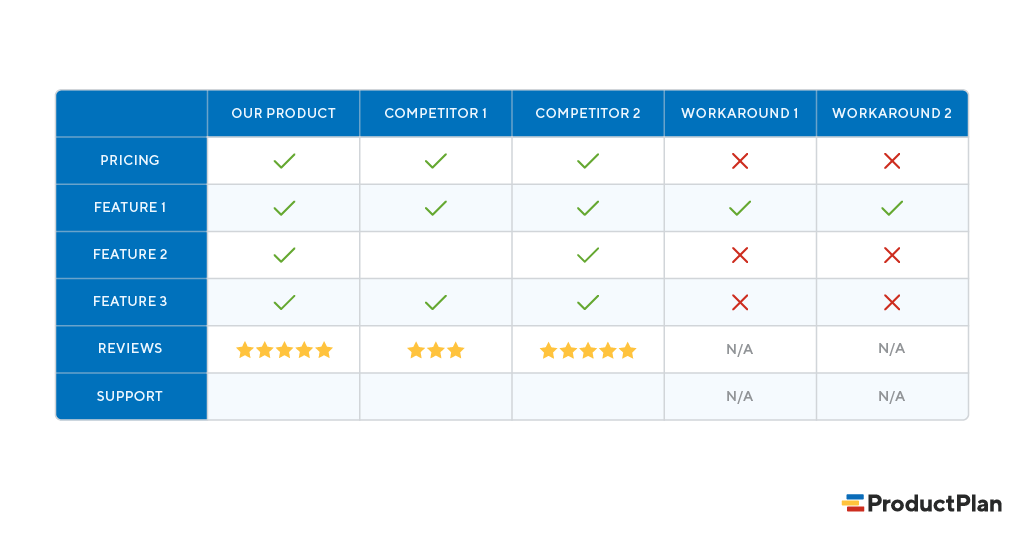What Does Competitive Landscape Mean?
The competitive landscape refers to the list of options a customer could choose rather than your product. The list includes your competitors’ products and other types of customer solutions. A customer might also choose to purchase a product.
What Is a Competitive Landscape Analysis?
Gaining a complete view of the competitive landscape will require research. Product teams should conduct a competitive analysis to learn all the alternatives to their product. This research often reveals that the competitive landscape is larger than the team assumed.

How Do You Perform a Competitive Landscape Analysis?
We offer several suggestions in our two articles on this topic—the best ways for product managers to research their competitors and conduct an effective competitive analysis every time. We’ll summarize our favorite tips from those articles here.
1. Follow—and even “friend”—your competitors.
Subscribe to your competitors’ newsletters, join them on social media, and check out the content they publish on their sites. This strategy is a valuable way to learn about the new products they’re working on and which enhancements they’re planning for current products.
Assuming they are tuned in to the goals and frustrations of their potential users—meaning your potential users—these competitors’ priorities can clue you in on big problems your market wants to be solved.

2. Create a competitive comparison matrix.
As you learn more about what your competitors are offering, you’ll want to get the complete picture of how their solutions measure up against yours.
One best practice is to build a competitive matrix.
A competitive matrix can let you view side-by-side details of each competitive product in your market. Create columns to track the characteristics of each product, such as features, pricing, customer support, average customer reviews, etc.
3. Add “alternative solutions” to your competitive landscape.
When you’re thinking through all the ways a customer could solve the problem your product addresses, you’ll want to use your imagination—or market surveys. People can find creative ways to get things done that don’t involve buying a product built to solve that problem.
If your target market is using a different type of tool—even something free—to solve their problem, you’ll need to know that, so you can make sure your product offers something more.
What Are the Benefits of a Competitive Landscape Analysis?
Why would your team perform competitive analysis in the first place? Is it worth the effort? It is, and here are some of the biggest reasons.
1. You can avoid costly missteps.
When you conduct a thorough analysis of the competitive landscape, including identifying alternative solutions your prospective customers might already be using, you can save time and resources.
Rather than building something your market doesn’t need—because they’ve found a workaround—you will instead move your resources over to addressing a problem the market needs solving and is interested in buying.
2. You can discover new ideas.
Your product team might have an effective strategy for communicating with your target users and learning about their priorities. That’s great. But no matter how effective that process is, you won’t catch every new trend or market need. By reviewing what your competitors are up to, you can also gain collective insights from their market research.
In addition to helping you uncover new product or feature ideas, a competitive landscape analysis can also help you find ways to improve your customer journey. When you sign up to receive your competitors’ content, for example, you’ll learn how they move their prospects through the content and sales funnel. This strategy reveals a gap or weakness in your company’s sales and marketing experience—which you can now fix.
3. You can find new markets, industries, and user personas.
When you perform a competitive landscape analysis, you’ll get a close look not only at the products your competitors sell but also where they’re selling them. This process is one of the most eye-opening and productive aspects of competitive analysis.
Your team might learn, for example, that a competitor has found a way to solve a problem for an industry your company hadn’t even considered targeting. If your product offers similar functionality, you might find success in pursuing that industry as well. Discoveries like this could even lead your team to an expanded view of your product’s value proposition—and help you find other markets your competitors haven’t pursued yet.
Related Terms
product differentiation, unique selling proposition, value proposition, user research, product-market fit